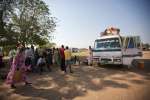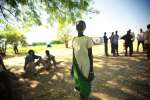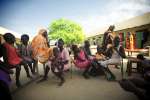Liquid treasure: The challenge of providing drinking water in a new refugee camp
News Stories, 4 July 2013
AB GADAM, Chad, July 4 (UNHCR) – Many people like to have a glass of water beside their bed in case they get thirsty in the middle of the night. Zenab keeps a jerry can full of the precious fluid. "That's our emergency ration," she explained to UNHCR.
The mother of five is a refugee from Sudan's troubled West Darfur region and she lives in a camp in a semi-arid area of south-east Chad, where clean water is a luxury rather than a bountiful resource. Ensuring that all 14,000 refugees in the newly opened Ab Gadam camp get sufficient water to drink and cook with is a major challenge.
The recommended minimum in an emergency situation is 15 litres per person per day, but in Ab Gadam, UNHCR and its partners are struggling to reach 10 litres per person a day by filtering water from a nearby lake, which will be the camp's main source of water when the rains come and cut off Ab Gadam. The minimum survival level is seven litres.
"It is really serious . . . We need to increase the supply – and that is what we are working on," said Dominique Porteaud, UNHCR's senior water and sanitation officer. He added that without sufficient clean water, people would go to alternative, untreated sources and this could lead to the outbreak of diseases.
Zenab, however, is grateful to have any water and explains that "in our village [Ab Garadil] we had a water pump, but everything was destroyed [when it was attacked]." She, her husband and their children are among thousands of Sudanese and Chadians who have fled to the Tissi region to escape inter-communal fighting in West Darfur since January.
The family spent weeks in the remote and difficult to access border area, drinking unsafe water from small holes they dug in the ground. Zenab's youngest child, two-year-old Ali, became sick and is still poorly. When UNHCR met the family, he was being treated for diarrhoea in the Ab Gadam camp`s health post – a reminder of the importance of clean water, sanitation and hygiene in an emergency setting like this.
Before and since moving people away from the dangerous border area of Tissi over recent weeks, UNHCR and its partners have been looking at ways to ensure a sufficient flow of water, enough at least to meet needs for drinking and cooking, if not for washing. This becomes more difficult now with the onset of the rainy season and UNHCR is fortifying the dusty roads from the lake to the camp.
"It's a paradox," said Philippe Creppy, UNHCR's emergency coordinator in the region. "We are racing against the water from the coming rains while simultaneously mobilizing all efforts to supply drinking water."
Since the camp opened in May, UNHCR has been trucking in water from a lake in the town of Tissi. But Tissi will be cut off when the rains come and so the UN refugee agency has been looking at implementing other measures to maintain and eventually boost water supply. These include increasing the number and size of water storage tanks and bladders on site, increasing the number of water tankers and continuing the search for productive boreholes, with some success at the end of June.
While UNHCR is encouraged by this find, the main source of water for the time being will be a lake located about nine kilometres from Ab Gadam. The problem with the lake is that the water is impure and unsafe to drink. However, a water treatment plant has been built with the help of the Norwegian Church Aid and the International Rescue Committee.
Treated with chemicals in big onion-shaped tanks, the brown lake water comes out clear, clean and ready to drink and cook with after an 11-hour cycle. Currently, the plant can produce enough clean water to supply every refugee with at least 10.5 litres per day, above the minimum survival level but still way short of the recommended minimum for emergency situations.
So, although there are no queues in the camp for water, the International Rescue Committee is installing another treatment plant while the drilling of boreholes continues apace.
And some refugees are finding their own sources of fresh water. Zenab's friend Halima collects rainwater, just like she used to do in her village, and uses it to clean clothes, pots and pans and her family.
Like Zenab, she understands how precious and vital for health clean water is. But not everyone knows of the dangers and so UNHCR and its partners run awareness programmes on the importance of clean water, sanitation and hygiene. "It is important that everybody, including the children, know about the best use of water and the dangers of drinking dirty water," says Barka Mahamat Barka, a UNHCR water and sanitation expert.
What's more, the refugees themselves are being involved in the efforts to make best use of water supplies. A refugee water committee was recently elected to monitor the water supply.
Meanwhile, Zenab and her family are grateful for their daily ration of about 80 litres of water. But she still worries about the future, and that's why she keeps the jerry can full of water in reserve – it makes her feel a bit safer.
By Ruth Schoeffl in Ab Gadam, Chad























































